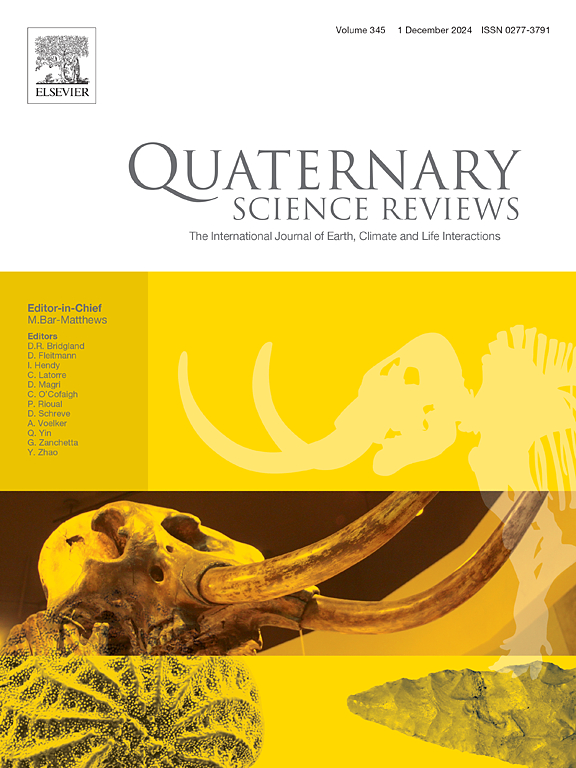不同大西洋经向翻转环流和末次消冰期海温情景下亚马逊河流域过去降水
IF 3.2
1区 地球科学
Q1 GEOGRAPHY, PHYSICAL
引用次数: 0
摘要
大西洋经向翻转环流(AMOC)强度的变化被认为会影响热带雨带的平均纬度和南美季风系统的强度。这些变化影响了亚马逊的降水模式,而降水模式对维持地球上最具生物多样性的生态系统起着至关重要的作用。因此,预估的AMOC强度响应人为气候变化的下降可能对亚马逊雨林的稳定性构成严重威胁。在末次冰期和去冰期的大多数千禧年尺度冰期(如Heinrich冰期(HS)), AMOC强度显著降低。这些数据提供了宝贵的机会来了解AMOC的减缓,以及大尺度海洋和大气条件(如海冰范围、地面风、冰盖高度和范围、海平面)的其他同步变化对亚马逊降水的影响。本文重建了亚马逊盆地27.4 ~ 3.6 cal ka BP的降水变化,主要集中在Heinrich Stadial 1 (HS1, 18.6 ~ 14.6 cal ka BP)和新仙女木期(YD, 12.9 ~ 11.7 cal ka BP,也称为Heinrich Stadial 0)。为了实现这一点,从西赤道大西洋的斜坡上收集的两个海洋沉积物岩心进行了放射性碳定年和主要元素组成分析。为了支持我们的数据解释,我们采用了(i)对亚马逊河流域主要河流悬浮沉积物中主要元素组成的综合评估,(ii)热带南美洲水文气候记录的区域汇编,以及(iii)覆盖过去21 ka的瞬态全耦合气候模式运行的输出。结果表明,HS1和YD期间亚马逊流域降水模式的差异与热带辐合带(ITCZ)的非均质位移和赤道西大西洋和赤道东太平洋海温(SST)的非均质异常有关。这些变化至少部分与不同的AMOC情景有关。此外,在HS1中可以识别出两个不同的相(即HS1a从18.6到16.6 cal ka BP, HS1b从16.6到14.6 cal ka BP),每个相都以Al, K, Ca, Ti和Fe的相对浓度变化为特征。我们解释这些沉积物组成的变化与主要降水地点的转移有关,从安第斯山脉中部(HS1a)转移到亚马逊河东南部(HS1b)。HS1b期间,赤道东太平洋低压区(由于赤道东太平洋相对于赤道西大西洋有更强的海温正异常)以及ITCZ位置进一步南移,在亚马逊盆地南部和东部产生了一个正降水异常。YD期间的降水异常明显不那么明显,位于亚马逊盆地东部,但我们不能排除主要元素信号受到海平面显著上升影响的可能性,海平面上升增加了大陆架上陆源沉积物的容纳空间。不同AMOC情景下降水的非均匀响应强化了亚马逊流域高时间分辨率古气候研究的重要性,以及由于盆地大陆维度的关系,对这些事件的降水响应进行空间划分的必要性。本文章由计算机程序翻译,如有差异,请以英文原文为准。
Past Amazon precipitation under different Atlantic Meridional Overturning Circulation and sea surface temperature scenarios of the last deglaciation
Changes in the strength of the Atlantic Meridional Overturning Circulation (AMOC) have been suggested to affect the mean latitude of the tropical rain-belt and the intensity of the South American Monsoon System. These changes impact Amazonian precipitation patterns, which play a critical role in sustaining the most biodiverse ecosystem on Earth. Consequently, the projected decrease in AMOC strength in response to anthropogenic climate change may constitute a serious risk to the stability of the Amazon rainforest. AMOC strength was significantly reduced during most millennial-scale stadials (e.g., Heinrich Stadials (HS)) of the last glacial and deglacial periods. These stadials offer valuable opportunities to understand the impact that slowdowns of the AMOC, as well as other concurrent changes of large-scale ocean and atmospheric conditions (e.g., sea ice extent, surface winds, ice sheet height and extent, sea level), had on Amazonian precipitation. Here we reconstruct precipitation changes that occurred in the Amazon Basin from 27.4 to 3.6 cal ka BP with a focus on Heinrich Stadial 1 (HS1, 18.6–14.6 cal ka BP) and the Younger Dryas (YD, 12.9–11.7 cal ka BP, also known as Heinrich stadial 0). To achieve this, two marine sediment cores collected from the slope of the western equatorial Atlantic were radiocarbon dated and analyzed for major elemental composition. To support the interpretation of our data, we employed (i) a comprehensive evaluation of major elemental composition in suspended sediments from the major rivers of the Amazon Basin, (ii) a regional compilation of tropical South American hydroclimate records, and (iii) outputs from a transient fully-coupled climate model run covering the last 21 ka. Our results reveal different precipitation patterns in the Amazon Basin during HS1 and the YD that were related to heterogenous displacements of the Intertropical Convergence Zone (ITCZ) and heterogenous sea surface temperature (SST) anomalies in the western equatorial Atlantic and the eastern equatorial Pacific. These changes were at least in part associated to different AMOC scenarios. Furthermore, two distinct phases are discernible within HS1 (i.e., HS1a from 18.6 to 16.6 cal ka BP and HS1b from 16.6 to 14.6 cal ka BP), each being characterized by variations in the relative concentrations of Al, K, Ca, Ti, and Fe. We interpret these sediment composition changes to be related to a shift in the main precipitation locus, that moved from the central Andes (HS1a) to southeastern Amazonia (HS1b). During HS1b, the low-pressure region over the eastern equatorial Pacific (due to a stronger positive SST anomaly in the eastern equatorial Pacific relative to the western equatorial Atlantic) produces, together with a shift further south in the ITCZ position, a positive precipitation anomaly over the southern and eastern Amazon Basin. Precipitation anomalies during the YD were apparently less conspicuous, located in the eastern Amazon Basin, but we cannot exclude the possibility of major elemental signals to be affected by a significant sea level rise that increased accommodation space for terrigenous sediments on the continental shelf. The heterogeneous response of precipitation under different AMOC scenarios reinforces the importance of high-temporal resolution paleoclimate studies from the Amazon Basin and the need to spatially compartmentalize the precipitation responses to these events due to the continental dimension of the basin.
求助全文
通过发布文献求助,成功后即可免费获取论文全文。
去求助
来源期刊

Quaternary Science Reviews
地学-地球科学综合
CiteScore
7.50
自引率
15.00%
发文量
388
审稿时长
3 months
期刊介绍:
Quaternary Science Reviews caters for all aspects of Quaternary science, and includes, for example, geology, geomorphology, geography, archaeology, soil science, palaeobotany, palaeontology, palaeoclimatology and the full range of applicable dating methods. The dividing line between what constitutes the review paper and one which contains new original data is not easy to establish, so QSR also publishes papers with new data especially if these perform a review function. All the Quaternary sciences are changing rapidly and subject to re-evaluation as the pace of discovery quickens; thus the diverse but comprehensive role of Quaternary Science Reviews keeps readers abreast of the wider issues relating to new developments in the field.
 求助内容:
求助内容: 应助结果提醒方式:
应助结果提醒方式:


